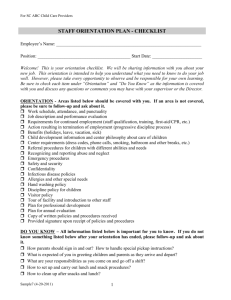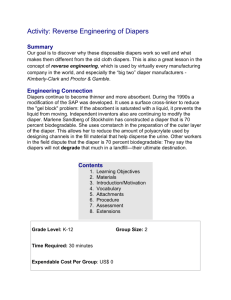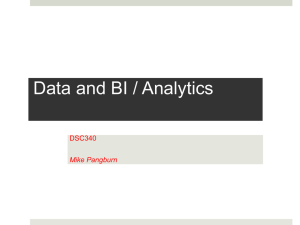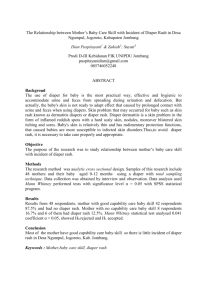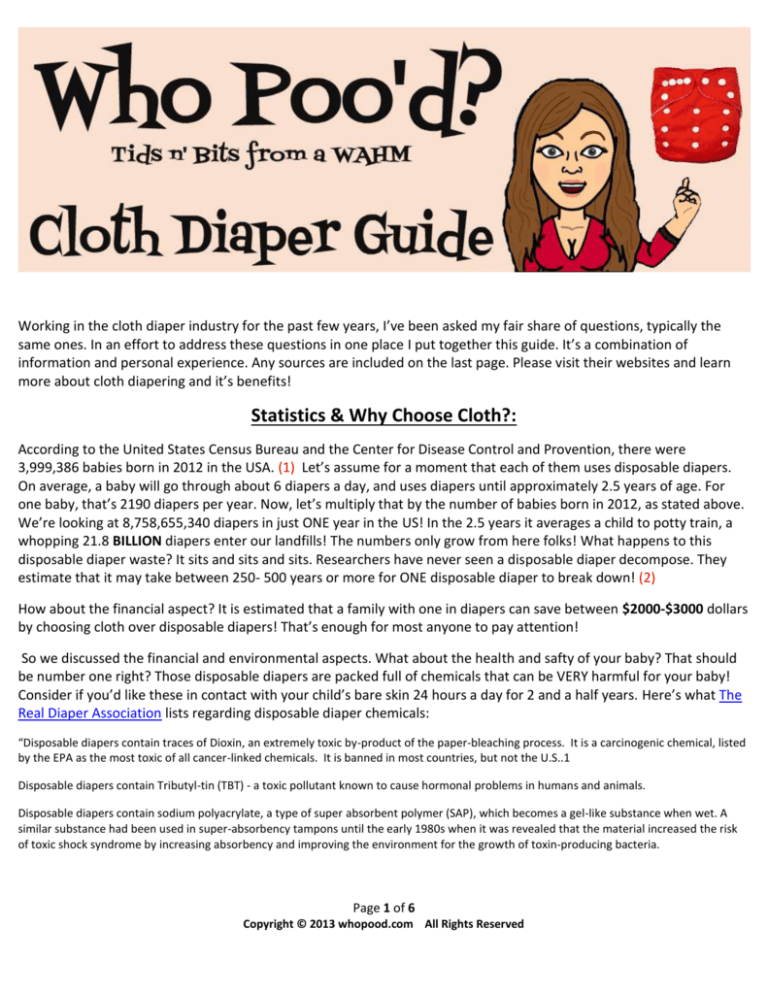
Working in the cloth diaper industry for the past few years, I’ve been asked my fair share of questions, typically the
same ones. In an effort to address these questions in one place I put together this guide. It’s a combination of
information and personal experience. Any sources are included on the last page. Please visit their websites and learn
more about cloth diapering and it’s benefits!
Statistics & Why Choose Cloth?:
According to the United States Census Bureau and the Center for Disease Control and Provention, there were
3,999,386 babies born in 2012 in the USA. (1) Let’s assume for a moment that each of them uses disposable diapers.
On average, a baby will go through about 6 diapers a day, and uses diapers until approximately 2.5 years of age. For
one baby, that’s 2190 diapers per year. Now, let’s multiply that by the number of babies born in 2012, as stated above.
We’re looking at 8,758,655,340 diapers in just ONE year in the US! In the 2.5 years it averages a child to potty train, a
whopping 21.8 BILLION diapers enter our landfills! The numbers only grow from here folks! What happens to this
disposable diaper waste? It sits and sits and sits. Researchers have never seen a disposable diaper decompose. They
estimate that it may take between 250- 500 years or more for ONE disposable diaper to break down! (2)
How about the financial aspect? It is estimated that a family with one in diapers can save between $2000-$3000 dollars
by choosing cloth over disposable diapers! That’s enough for most anyone to pay attention!
So we discussed the financial and environmental aspects. What about the health and safty of your baby? That should
be number one right? Those disposable diapers are packed full of chemicals that can be VERY harmful for your baby!
Consider if you’d like these in contact with your child’s bare skin 24 hours a day for 2 and a half years. Here’s what The
Real Diaper Association lists regarding disposable diaper chemicals:
“Disposable diapers contain traces of Dioxin, an extremely toxic by-product of the paper-bleaching process. It is a carcinogenic chemical, listed
by the EPA as the most toxic of all cancer-linked chemicals. It is banned in most countries, but not the U.S..1
Disposable diapers contain Tributyl-tin (TBT) - a toxic pollutant known to cause hormonal problems in humans and animals.
Disposable diapers contain sodium polyacrylate, a type of super absorbent polymer (SAP), which becomes a gel-like substance when wet. A
similar substance had been used in super-absorbency tampons until the early 1980s when it was revealed that the material increased the risk
of toxic shock syndrome by increasing absorbency and improving the environment for the growth of toxin-producing bacteria.
Page 1 of 6
Copyright © 2013 whopood.com All Rights Reserved
In May 2000, the Archives of Disease in Childhood published research showing that scrotal temperature is increased in boys wearing disposable
diapers, and that prolonged use of disposable diapers will blunt or completely abolish the physiological testicular cooling mechanism important
for normal spermatogenesis.” (3)
If that doesn’t make you think twice, I don’t know what will! Now let’s take a look at what types of cloth diapers are
available to you. With so many options, you’re bound to find one to suit your needs!
Types of Cloth Diapers:
Pockets or Sleeve
This is the most popular cloth diaper style. Similar to the AIO, except the absorbant layer can be removed through 1 or
2 pocket openings located at the front, back or middle depending on the brand. Pocket diapers have 1 pocket opening
while Sleeve diapers have 2, one in front and one in back. This allows the insert to agitate out on it’s own during the
wash cycle. To use, you stuff the insert into the pocket.
PROs: Faster drying time, easy to use,
CONs: With the exception of the Sleeve style, pockets require that the insert be removed prior to washing. Pockets
need to be stuffed with an insert prior to use and can be a tad more time consuming, although many people enjoy it!
All In One (AIO)
This cloth diaper is most similar, in funtion, to a disposable and therefor, most user friendly. It consists of a waterproof
layer and several absorbant layers all sewn together in one. Get it? All in one? ;) It will have a snap or velcro closure
method and can be found in sized and onesize options. It comes in a variety of materials including microfleece or
suede, microfiber, cotton, bamboo and hemp amoung others.
PROs: Due to it’s simple function and use, AIO’s are a popular choice for daycare, daddies grandparents and
babysitters. No muss no fuss system.
CONs: Longer than average drying time. Unable to adjust or customize absorbancy for heavy wetters.
All In Two (AI2)/Hybrid:
This diaper is similar to a pocket diaper, except instead of stuffing the insert into a pocket, it’s snapped into the
waterproof shell and sits next to the baby’s bottom. The snapped on insert can be removed and replaced with the
same cover as long as the cover or shell hasn’t been soiled. Some AI2’s are available with disposable absorbant inserts
that lay on the diaper and can be discarded and in some cases flushed. When using it in this way it’s called a hybrid.
Available in sized, one size, snap and velcro.
PROs: Like the AIO this is an easy to use type of diaper. Dries much faster than an AIO. When used with disposable
inserts (hybrid) it’s a great method when travelling.
CONs: In most cases, you have to use the same brand of insert as the diaper. It’s not as easy to adjust absorbancy.
Page 2 of 6
Copyright © 2013 whopood.com All Rights Reserved
Prefold or Flat
These are the diapers that most think of when they hear, “cloth diapers”. A prefold is a rectangular square of cotton,
typically Chinese cotton or Indian cotton, that has several layers of fabric with a thicker layer in the middle. Most
commonly there will be 4 layers on the outter left and right and 8 layers in the middle. You’ll see this described as
4x8x4. They can come in sizes or in a one size option.
A flat diaper is just a
very large square of cotton, as thin as a cotton T-shirt, that can be folded many times to create several layers of
absorbancy. Both of these are not waterproof when used alone, and typically require a method of securing them in
place like safty pins or another type of diaper fastener.
PROs: Both are VERY affordable! They dry very fast, especially flats. They can be reused as garage or cleaning rags after
the baby is potty trained.
CONs: They require folding and can be a bit more difficult for daycares, dads or caregivers with no previous experience.
One size prefolds tend to be a bit bulkier.
Fitted or Contour:
Fitteds and contours are essentially an AIO with the exception that there is NOT a waterproof layer built in. The entire
diaper is made of absorbant material so it’s great for heavy wetters. They do require a waterproof cover of some kind
in order to hold the moisture in. These diapers will often have leg elastic ans snaps or velco, although some styles do
not. Available sized or in one size.
PROs: A fantastic option for heavy wetters or night diapering. Np pins or fastners required. Due to leg elastic, they
contain messes better than a prefold or flat.
CONs: A longer than average drying time. They require a diaper cover in order to be waterproof.
Covers:
Covers are simply a waterproof layer that you put over a prefold, flat, fitted or contour diaper. The most common is
made of PUL (polyurithan laminate) and come sized or one size, with snaps or velcro. Wool and fleece can also be used
as covers and are typically sized.
PROS: PUL- Easy to clean, keeps diaper from leaking. Wool/Fleece- Great for heavy wetters. Wool is naturally
antimicrobial and antibacterial!
CONs: Wool requires lanolization to be waterproof and both wool and fleece must be hand washed and layed flat to
dry. It’s a bit more work, but many swear by it and won’t use anything else. Both wool and fleece will shrink if washed
and dried in an washer and dryer.
How Many Diapers?
This varies and depends greatly on you and baby. A newborn uses 8-10 diapers per day. As they grow, this tapers off to
about 6. So ask yourself,”How often do I want to wash diapers?”. If you don’t mind washing daily, you can get by on 1215. The average user has a minimum of 20-25 and washes every other to every third day.
There are SO many affordable options out there! You can have a stash of 20-25 diapers for less than $100! Ask me
how!! I have the skinny on the most affordable options whether you want prefolds and covers or pockets!
Page 3 of 6
Copyright © 2013 whopood.com All Rights Reserved
Types of Accessories:
Inserts/Doublers
These are the absorbant layers that can be added to increase absorbancy in most cloth diapers. They come in many
sizes, but are typically narrow in width. They can be made of cotton, hemp, bamboo, microfiber, zorb and more! They
can be stuffed into pockets or laid inside. (It’s never recommended to place microfiber directly against baby’s skin as it
can cause irritation and dryness due to it’s highly absorbant nature.)
Pail/Pail Liner/Wetbag
You need something to place dirty diapers in until laundry day. Enter the pail, pail liner, and wetbag.
The most common “pail” is a simple 13 gallon trash can. I got mine at the local dollar store for $7! Many use smaller
cans in their nursury or bathroom. It depends on what you prefer.
A pail liner is basically a reusable trash bag made from waterproof PUL. They can have elastic at the top or a drawstring
to secure them onto your pail.
A wetbag is also a waterproof bag that typically has a zipper closure to keep smells and moisture in. They can come in
very large sizes that hang from doorknobs or dresser handles. This eliminates the need for a pail. They also come in
medium, small and travel sized to suit different needs. It’s always recommended to have a travel sized wetbag or two
when out and about so you have a place to put dirties until you get home. These are also FANTASTIC for soiled clothes!
If your child spills or gets carsick, you have a handy bag to keep the messy items in until you can properly deal with
them!
Diaper Sprayer
A diaper sprayer attaches to the back of your toilet and is used to spray poopy messes off the diaper and into the toilet.
Although many people use them, they’re not necessarily needed. You can swish the diaper around in the toilet,
designate a spatula or plastic knife to scrap, or even use a removable shower head if it’ll reach. Pretty much any
method you find successful, as long as you’re able to remove the solids prior to washing.
*If your child is EXCLUSIVELY breastfed, and solids have NOT been introduced yet, the poop is 100% organic and water soluable meaning it washes away easily in the washer.
Think of spilled yougurt. This does NOT require removal prior to washing. It’s only formula fed babies, or babies who have started on solids that need their poop removed.
Wipes:
Reusable wipes are another step towards saving money and decreasing waste! Many cloth wipes are available from
many different retailers and WAHM. They typically come in cotton, flannel, bamboo or terry cloth. Many have found
that the very best cloth wipes are those SUPER affordable baby wash cloths that you can get at dollar stores. You just
toss them in and wash them with your diapers! Easy peasy!
Fasteners:
If the type of diaper you are using does not have snaps or velcro and requires a fastener, such as prefolds and flats,
you’ll want to look into safty pins, Snappi’s or Boingo’s to secure them in place.
Page 4 of 6
Copyright © 2013 whopood.com All Rights Reserved
Diaper Ointment:
It is VERY important that you use a “cloth diaper safe” ointment/cream/saulve! Things like A&D and Desitin are NOT
safe to use with cloth! They create a film or barrier on the fibers of the diapers which repell liquids. Think oil and water.
You’ll want something that washes clean and doesn’t leave residue. A simple internet search will reveal a whole bunch
of brands. You can also use 100% organic coconut oil. It can be purchased everywhere and washes clean. Breastmilk,
used topically on the rash, is another natural option!
Detergent:
Just like diaper ointment, detergents MUST be “cloth diaper safe”. Softeners, whiteners and brighteners can also cause
repelling by building up a residue on the diaper’s fibers. There are a BUNCH of cloth safe options or you can make your
own very easily and save even more money! Recipes very, but here’s a common one:
2 (2lbs.) Boxes of Baking Soda
1 (4.75lbs) Box of Borax (Some think borax is harmful to cloth, but many use it without issue, including myself)
1 (3.7lbs) Box of Washing Soda
1 (3lbs) Tub of Oxyigen Powder
*Optional add in’s include a few drops of essential oils and/or 2 bars of grated Fels-Naptha or Dr. Bronner’s soap
Mix all ingedients well in a big tub or painter’s bucket. DONE!
This will cost you less than $30 and should last you approximately a year depending on how much you use and how
often! You can use it on regular laundry as well. Think of the savings!!
Washing Cloth Diapers:
This is the topic that brings the most anxiety for parents interested in cloth. Poop and washing! Never fear folks! It’s
easy as poo and honestly becomes second nature! You’re washing laundry every week anyway. What are 2-3 more
loads?
This is the most common/successful routine:
Place the diapers, wetbags and pail liners in the machine.
-Cold rinse
-Hot wash with 1-3 TBLS cloth safe detergent
-Cold rinse
-Optional, but recommended, additional cold rinse
Page 5 of 6
Copyright © 2013 whopood.com All Rights Reserved
Then you can tumble dry on low/medium low or line dry. Drying your diapers in the sun is a FANTASTIC way to remove
any stains in your diapers! The sun safely bleaches and disinfects them!!
The washing routine can be adjusted and tailored based on your type of water or machine. The main thing to
remember is the more water the better. Many HE machines use much less water. If your HE machine doesn’t allow
water adjustment, you can manually add more or trick the machine into adding more by adding a wet towel. In some
models you can also add water right into the basin or through the detergent hole of the machine.
We discussed what to do with poop under “Diaper Sprayer” in the Accessories section above. ↑↑
Finding your best washing routine can involve a bit of trial and error for some, but once you’ve found it you’re set!
When you’re diapers have finished their wash, smell them. If they stink, you may consider using a little more detergent
or water. If they smell like the detergent, use a tad less or add an additional rinse. You’re diapers shouldn’t really smell
like anything. Just the fabric. That means they’re properly cleaned. Are you noticing a stron ammonia smell when baby
wets? Try using ½ cup of white distilled vinegar in the final rinse or consider “stripping” them.
Keep in mind that all cloth diapers, regardless or what safe detergents and ointments you use, need to be “stripped”
every 3-6 months in order to insure they are functioning at peak performance. This simply means you wash the heck
out of them, several times, without detergent.
Stripping Your Diapers
Start with clean diapers and wash on hot (NEVER use a sanitize setting on PUL diapers. It’s a bit too hot) for a full cycle.
Repeat 1-2 more times. This simply removes any residues that may be accumulating on the fibers. Now if you’ve used a
non safe detergent or ointment and it’s caused your diapers to repell, you may need to do a stronger strip using a TBLS
of blue Dawn dishsoap in the initial wash and following with a TON of rinses until there are zero bubbles and they’ve
rinsed clean. Again, an internet search will reveal several methods if you’d prefer a different one, but these are the
most common.
Questions, Comments?
Feel free to email me! It is my absolute joy to help you through this process and make sure your cloth journey
is a successful one!
melissa@whopood.com
melissa@lovelypocketdiapers.com
Sources:
(1) The US Census Bureau- www.census.gov The Center for Disease Control and Prevention- www.cdc.gov
(2,3) The Real Diaper Association- www.realdiaperassociation.org
The Eco Friendly Family www.theecofriendlyfamily.com Amanda, the mom behind The Eco Friendly Family, has also created a cloth diaper
document that has fantastic information and visual aids to assist you in making the best choice for your cloth diapering needs! You can find it
here: http://www.theecofriendlyfamily.com/docs/ClassInfoHandoutWebVersion.pdf
Page 6 of 6
Copyright © 2013 whopood.com All Rights Reserved

